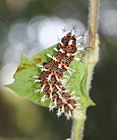Note: This is a project under development. The articles on this wiki are just being initiated and broadly incomplete. You can Help creating new pages.
Smilax china - Madhusnuhī
Madhusnuhī consists of tuberous root of Smilax china Linn. (Fam. Liliaceae), a deciduous climber with sparsely prickled or unarmed stem. It is imported from China and Japan.
Contents
[hide]- 1 Uses
- 2 Parts Used
- 3 Chemical Composition
- 4 Common names
- 5 Properties
- 6 Habit
- 7 Identification
- 8 List of Ayurvedic medicine in which the herb is used
- 9 Where to get the saplings
- 10 Mode of Propagation
- 11 How to plant/cultivate
- 12 Commonly seen growing in areas
- 13 Photo Gallery
- 14 References
- 15 External Links
Uses
Herpetism, Syphilis, Rheumatism, Chronic rheumatism, Nausea, Vomiting, Skin diseases, Syphilis, Epilepsy, Insanity, Flatulence, Dyspepsia, Constipation.
Parts Used
Chemical Composition
Phytochemical screening of methanol extract yielded flavonoids, tannins, alkaloids, saponins, and glycosides, Root contains fat, sugar, glucoside, coloring matter, gum and starch[1]
Common names
| Language | Common name |
|---|---|
| Kannada | |
| Hindi | Chopcheenee |
| Malayalam | China Pairu |
| Tamil | Parangichekkai |
| Telugu | Pirngichekka |
| Marathi | NA |
| Gujarathi | NA |
| Punjabi | NA |
| Kashmiri | NA |
| Sanskrit | Dvīpāntara Vacā |
| English | China root |
Properties
Reference: Dravya - Substance, Rasa - Taste, Guna - Qualities, Veerya - Potency, Vipaka - Post-digesion effect, Karma - Pharmacological activity, Prabhava - Therepeutics.
Dravya
Rasa
Guna
Veerya
Vipaka
Karma
Prabhava
Habit
Identification
Leaf
| Kind | Shape | Feature |
|---|---|---|
| Paripinnate | Oblong | Leaf Arrangementis Alternate-spiral |
Flower
| Type | Size | Color and composition | Stamen | More information |
|---|---|---|---|---|
| Unisexual | 2-4cm long | pink | Flowering throughout the year and In terminal and/or axillary pseudoracemes |
Fruit
| Type | Size | Mass | Appearance | Seeds | More information |
|---|---|---|---|---|---|
| oblong pod | Thinly septate, pilose, wrinkled | seeds upto 5 | Fruiting throughout the year |
Other features
List of Ayurvedic medicine in which the herb is used
Where to get the saplings
Mode of Propagation
How to plant/cultivate
Succeeds in most well-drained soils in sun or semi-shade. Hardy to about -15°c. A climbing plant, supporting itself by means of tendrils and thorns as it scrambles through small trees and shrubs. [3]
Commonly seen growing in areas
Mossy forests, Tropical area, Subtropical area.
Photo Gallery
References
- Jump up ↑ The Ayuredic Pharmacopoeia of India Part-1, Volume-5, Page no-14
- Jump up ↑ [ "Morphology"]
- Jump up ↑ "Cultivation detail"
External Links
- Pages that are stubs
- Ayurvedic Herbs known to be helpful to treat Herpetism
- Ayurvedic Herbs known to be helpful to treat Syphilis
- Ayurvedic Herbs known to be helpful to treat Rheumatism
- Ayurvedic Herbs known to be helpful to treat Chronic rheumatism
- Ayurvedic Herbs known to be helpful to treat Nausea
- Ayurvedic Herbs known to be helpful to treat Vomiting
- Ayurvedic Herbs known to be helpful to treat Skin diseases
- Ayurvedic Herbs known to be helpful to treat Epilepsy
- Ayurvedic Herbs known to be helpful to treat Insanity
- Ayurvedic Herbs known to be helpful to treat Flatulence
- Ayurvedic Herbs known to be helpful to treat Dyspepsia
- Ayurvedic Herbs known to be helpful to treat Constipation
- Herbs with Roots used in medicine
- Herbs with Stem used in medicine
- Herbs with Leaves used in medicine
- Herbs with Rhizome used in medicine
- Herbs with common name in Hindi
- Herbs with common name in Malayalam
- Herbs with common name in Tamil
- Herbs with common name in Telugu
- Herbs with common name in Sanskrit
- Herbs with common name in English
- Habit - Climbing vine
- Index of Plants which can be propagated by Seeds
- Herbs that are commonly seen in the region of Mossy forests
- Herbs that are commonly seen in the region of Tropical area
- Herbs that are commonly seen in the region of Subtropical area
- Herbs
- Smilacaceae






